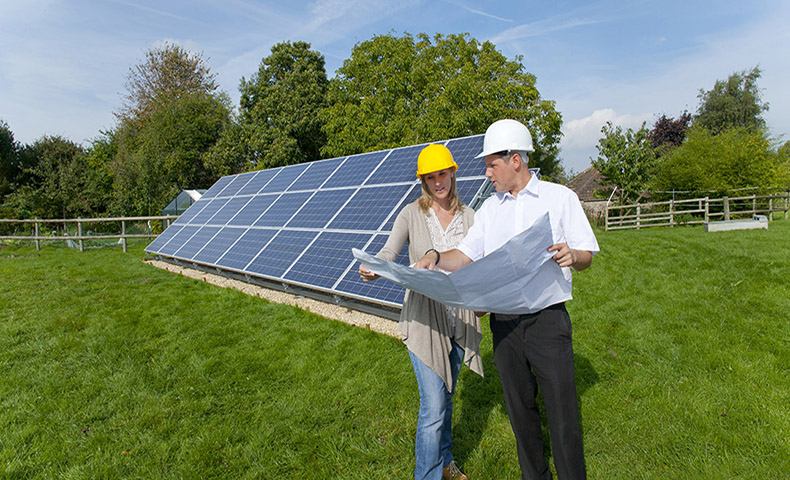
If you’re in the market for a solar power system for your home, you can find hundreds of pages with information about the environmental benefits and savings in electricity this will represent in the long run.
But more than anything, you want to know how much will it cost to put those panels on your roof so you can start reducing the ever increasing electrical bill.
One way to easily and rapidly find out is to access the Hahasmart site where you can input your address and your average monthly utility bill and in a matter of seconds you will get an estimate of the cost of a solar system for your house.
Once the contractor gets to your home and examines your particular needs and set up, the actual cost of installing your solar system may vary, depending on a number of factors.
Here are some of them:
The panels
According to the journal of Energy and Environmental Science, 90% of photovoltaic (PV) solar panels (or modules) are made from two main type of solar cells: monocrystalline (black) and polycrystalline (blue) silicon. Silicon is a highly durable chemical element that converts the energy from the sun into electricity. Monorcrystalline solar panels are by far the oldest and most commonly used. They are slightly more expensive than its counterpart but their efficiency is also slightly higher. Polycrystalline solar panels tend to have lower cost, but their efficiency has improved tremendously in recent years and now the difference with monocrystalline is almost non existent. There are other variations with the panels. Do you want silver (clear) frames or BOB (black-on-black)?
How much electricity do you consume?
Are there 3 or 10 of you living in the house, each using a TV, enjoying a central air conditioning or heating unit? Or do you have an electric car you want to charge at home? The more electronics or electric appliances you have, the higher the energy consumption.
The number of solar panels needed for your solar power system will be based on the amount of energy you consume. You can find this out fairly quickly by looking at your utility bill to determine average monthly electricity usage in kilowatt hours (kWh).
According to the U.S. Energy Information Administration, the average U.S. residential customer uses approximately 909 kWh per month of energy, or around 10,909 kWh per year.
Once you figure out this number, you can determine the amount of wattage you need your array of solar panels to produce to cover 100% of your energy usage or 80%? The more wattage capacity required, the more panels or the higher wattage you need from those modules.
The Inverter
String inverters, where a series of panels are “stringed” together into a central monitor are the most common and cost-effective set up in today’s market. But if you want maximum control over your solar system, another option are microinverters that go on each panel individually, converting the DC (direct current) energy produced by that module into AC (alternating current). While these type of inverter has somewhat higher cost, their individual set up allows for more leeway in terms of how and where you put the panels.
The location of the panels
Most residential homes opt for the roof to mount their solar modules simply because of the lack of space in their property. But if you have sufficient land, you might want to opt for ground-mounted arrays. Either one will have a different price tag.
If you go for the roof, its configuration may also influence the cost. Is your home multiple stories, is there a steep slope on the roof, clay or slate roof tiles, electrical upgrades required to meet code?
Also important is the amount of space on the roof. The less space, the fewer panels you can place on it, and the installation will obviously cost less. The orientation of the roof is another point.
Preferably, solar modules should be facing the south or the west for maximum exposure to the sun and thus higher electricity output.
The amount of mounting racking
Just as the amount of solar panels is based on your energy use, the quantity of modules determines how much racking system is needed to mount them on. Each solar installer has a preference for a mounting system to use for each type of situation.
Solar panels don’t sit on the actual roof of a house, but on racking material that leaves a space between the solar modules and the actual roof. This allows for free air flow under the modules to keep them from overheating.
Additional things to consider are labor costs. One way to make sure you’re getting the best overall value is to get quotes from different installers and gage their expertise.
After all, you want your solar system to fill your electricity needs for many years to come, so you should try to get the best option before starting out on the solar journey.
HahaSmart Blog - More Solar Tips and Guide
HahaSmart News - Stay Informed
Your Solar Incentives - See Credits and Incentives in Your Area
Check Your Home's Solar Price - See How Much You Save
Register Now - Unlock The Lowest Solar Prices in Your Area


Input your address to see if it is solar friendly and how much you can save with solar.
Great. Your address is perfect for solar. Solar incentive is still available. Select monthly utility cost and calculate the size of solar system you will need now.
| kw System size | years Payback period | Lifetime savings |
No money down, 100% finance is available.
|
|
Check the price of solar panels in your area in a matter of seconds! |
Comments